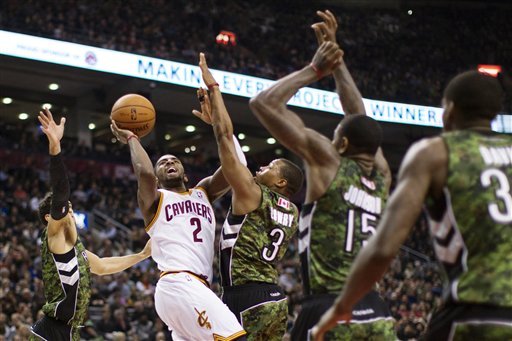Draft Q&A with Alex Rucker
We are planning to do a more comphresive feature on the Raptors’ investment in Analytics, including a focus on consultants Alex Rucker (who’s moved to Toronto and will be full time on July 1st) and LA based Keith Boyarsky. However, I thought it was best to “jump the gun” and focus on their role in this year’s draft as I was especially interested in getting their insights about the Raptors selections.
For background, Mr. Rucker (@Alex_Rucker) has a BComm from UBC and a Law degree from Notre Dame. He’s worked in various analytics roles with the Vancouver Grizzlies, Notre Dame Basketball and came to the Raptors in 2009. He met Jay Triano back when he was in high school and worked with him at Simon Fraser and the Grizzlies. He recently retired from the U.S. Navy after a 10 year commitment and will be working full time with the Raptors on July 1st with his analytics partner Keith Boyarsky (who was flying back to LA during this interview).
Tom Liston: When the Raptors selected Terrence Ross with the 8th pick, my immediate reaction was “jack of all trades, master of none”, meaning he does a lot of things reasonably well (TS%, 3pt%, rebounding for his position, etc) but doesn’t appear to excel in any one area.
- Where did the analytics team have him ranked?
- The big hole in my analysis is his potential impact on defense – were you able to distill some data on his impact?
- How did the process work in selecting this pick and how was the analytics team part of it?
Alex Rucker: Analytically, Ross was a very easy selection at 8th overall.
- We had him ranked as the 7th best prospect – and one of the guys ahead of him slid down the board due to medical concerns. When we got to our actual pick, we took the best player available. I agree with the general sentiment that he does a lot of things reasonably well – and that’s precisely one of the reasons he projected well in our in-house analytic tools. Unless you’re looking at a guy who can provide elite production in a key area, you’re often better served taking a player who can contribute positive value in multiple key phases of the game. I’d much rather have a guy who’s a slight positive in 6 areas at the pro level than a positive in 1-2 areas and a negative in the others. Bottom line:athletic wings who can hit the 3, play defense and get after it on the boards have positive value on nearly any team, regardless of how it’s constructed.We’re a team that’s building and improving, and based on the data we’d accumulated on him, Ross was a guy we assess will very quickly become a player who can contribute on both ends of the court.
- With respect to his defense – I agree that this is the hardest thing to discern from college data. College data is inconsistent and often difficult to both collect and work with, but there are absolutely some important inferences which can be drawn from it, even on the defensive end. Ross projected as a guy who will be a “plus” wing defender, both as an on-ball defender and as a help defender.
- The analytics team has been integrated into the draft process for the past 2-3 seasons. We are involved in the initial screening of candidates, essentially using our analytic suite to identify players who’s college data does not support taking them at our draft position – or at least make clear that if they are drafted, it will be purely on the basis of potential, not prior performance.
Additionally, our analysis has gotten pretty well-refined in terms of translating how a college prospect projects at the pro level based on identified roles and positions. Many players played a different position in college than they will at the pro level, and in a different role, and historical analysis allows us to do a better job of projecting what they’ll look like at our level.
At the end of the day, the final determination of a prospect is a mix of player evaluation, analytics, background checks, medical checks (both physical and psychological), etc. Our final draft board, I think, reflected our team’s invesment in each of those areas – but yes, it is clear that the analytic piece helped shaped both that list and the ultimate selection.
Liston: ESPN’s John Hollinger said “I had Ross 27th on my board. Not a fan of the pick and thought they could have traded down if that was their guy.” What is your rebuttal?
Rucker: It’s entirely possible we could have traded back and still gotten Ross. I know that Bryan Colangelo was extremely active throughout the entire draft, and he investigated a wide spectrum of options for our team. While we did have opportunities to move back, there was a very real chance that doing so might cost us the player we wanted. I think that Bryan weighed the benefits and risks associated with the various scenarios, and made the optimal decision for our franchise.
I’d also offer that the media’s perspective of player values is interesting, but it doesn’t always align with pro team’s perspectives – and one of those two enjoys a significant information advantage by virtue of the resources invested into the draft process.
If you look back historically, I think you’ll find that the real decisions (actual drafts) fare better in terms of assessing player value than the media projections (mock drafts). Neither is perfect, but one has less error than the other.
Liston: Who do you think is the biggest potential “steal” of the first round?
Rucker: Sullinger to Boston at 21. He has a chance to be a really good player at the pro level. Henson at 14 was another excellent pick. Both of those guys went later than I’d have selected them, and they ended up in great situations.
Liston: For the second pick, I was big on Jae Crowder, who went to Dallas – known for their big analytics team – right before your pick at 37.
- Was he on the radar?
- Why Quincy Acy, who doesn’t appear to fill a need a much as perhaps a Scott Machado, Tyshawn Taylor or Kim English (three others I was big on).
- Hollinger also didn’t like this pick – he noted: “Also, Quincy Acy over Quincy Miller continues a WTF night for the Raptors.” Your rebuttal?
Rucker:
- Crowder was definitely a player who was in the mix – but as you noted, he ceased to be an option 3 picks before ours.
- We liked Machado and Taylor, and they were given strong consideration – but the strong play by Ben Uzoh at the tail end of last season as a backup PG was a factor. Once you get into the 2nd round, analysis suggests that your best options are niche guys, players who can fit into an identifiable role and contribute positive value in that role. Acy is appears to a great fit with the team we’re building. Our assesments of him supported the position that he’s a guy who will do just that – give us a rugged, low-post battler who doesn’t take anything for granted and will be looking to compete anytime he steps onto the court.
We’re continuing to build a winning culture, one with a strong work ethic, a commitment to defense, a toughness – and Acy is going to be a positive contributor to that. - Quincy Miller is a talented player, and I’m looking forward to seeing how he does in Denver – which I think is a great spot for him. However, for our needs and what we were looking for, Acy was the guy. “Best player available” doesn’t exist in a vacuum. It exists in the context of your team, the players on your roster, and how that player will fit in with those things. I think sometimes people confuse “most potential” or “most skilled player” with “best”. Analytically, “best” relates to the sum of a player’s contributions to his team – and that’s rarely going to align with either of those two alternate definitions.
Liston: Who do you think is the biggest potential “steal” of the second round?
Rucker: While the odds are against any 2nd rounder being a useful NBA player, both Doron Lamb and Kim English are players who can clearly fit a role, and contribute positively in that role. I think both landed in great spots and am looking forward to seeing what they do going forward.
Liston: What can you tell us about Tomislav Zubcic?
Rucker: Zubcic is a 7′ combo forward from Croatia. He’s athletic, runs the floor, and looks to push the ball in transition. While he’s not a guy who can necessarily create shots for himself, he’s a strong spot-up shooter. The key for Zubcic will be his continued development. If he can get stronger and continue to refine his 3PT shooting, he could be a useful piece down the road.
Liston: Several Raptors’ fans were screaming (well, tweeting in ALL CAPS) for the team to acquire a late 1st rounder to pick up a dropping Perry Jones III. A) Was this considered? B) Where did you have him ranked?
Rucker: It should be no surprise that his analytic ranking would suffer as a result of his underwhelming play at the college level. He was not a player who projected well in our models, and his ability to contribute at the pro level will depend entirely on significant improvement going forward.
As with any trade scenario though, it’s easy to get excited about what you might be getting – the question is whether it’s a net positive once you factor in what you’re giving up, and what competing scenarios come off the table.
I think that we made positive-value decisions last night, and I can’t wait to see how the next few weeks unfold – there’s no question that we’re at a very high-leverage moment for our organization.
Liston: Thank you for your time. It was quite insightful.
Questions? There is a dedicated to “Statophile Q&A” forum thread here . If you prefer to send questions privately, you’re welcome to email me at tomliston [at] gmail [dot] com or find me on Twitter (@Liston).




